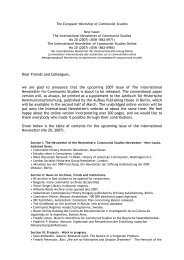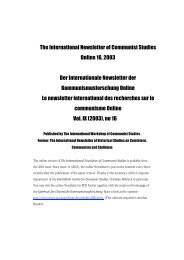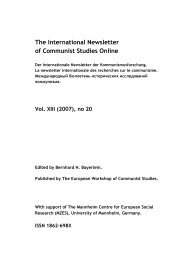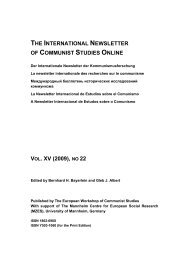VOL. XVI (2010), NO 23 - The International Newsletter of Communist ...
VOL. XVI (2010), NO 23 - The International Newsletter of Communist ...
VOL. XVI (2010), NO 23 - The International Newsletter of Communist ...
Sie wollen auch ein ePaper? Erhöhen Sie die Reichweite Ihrer Titel.
YUMPU macht aus Druck-PDFs automatisch weboptimierte ePaper, die Google liebt.
<strong>The</strong> <strong>International</strong> <strong>Newsletter</strong> <strong>of</strong> <strong>Communist</strong> Studies Online <strong>XVI</strong> (<strong>2010</strong>), no. <strong>23</strong> 22<br />
above, those who were actively trying to implement internationalism into society were a<br />
relatively small group <strong>of</strong> communist activists (though not necessarily party members). <strong>The</strong>y<br />
were confronted with potential incomprehension and opposition by a mostly peasant<br />
population that was largely concerned with local affairs rather than foreign matters, let alone<br />
solidarity with causes abroad. 32 Moreover, internationalism had to co-exist – sometimes in<br />
conflict, sometimes in a crude symbiosis – with xenophobic and anti-Semitic moods and<br />
images. 33 All these obstacles, frictions and controversies were reflected upon by activists on<br />
various levels, and already in the early 1920s heated discussions over the possibilities and<br />
impossibilities <strong>of</strong> communicating internationalism to the “broad masses” took place in the<br />
party press as well as in internal meetings. <strong>The</strong> project shall not leave these aspects aside,<br />
but embed these frictions into the social background against which internationalist practices<br />
were enacted.<br />
Also in a transnational sense, international solidarity in Soviet Russia was not performed in a<br />
vacuum, but took place against the background <strong>of</strong> a wave <strong>of</strong> revolutionary attempts in<br />
Europe and beyond. 34 Besides elaborating a typology <strong>of</strong> internationalist practices, the<br />
project’s aim is to put them into context <strong>of</strong> this international history in order to reveal<br />
developments, continuities and ruptures. To achieve this perspective, it seems operable to<br />
take a selection <strong>of</strong> episodes <strong>of</strong> social unrest and potential social transformation occurring<br />
throughout the world from 1918 until the late 1920’s, and using them as examples to trace<br />
their propagation and reception in Soviet Russia. This would allow holding the typology <strong>of</strong><br />
internationalist practices against different constellations <strong>of</strong> Soviet society and worldwide<br />
<strong>Communist</strong> movement. As such world-revolutionary focal points, I am considering the<br />
German „November Revolution“ <strong>of</strong> 1918, the Bavarian and Hungarian Soviet Republics <strong>of</strong><br />
1919, the Soviet Republic <strong>of</strong> Gilan (1920-1921), the “German October” <strong>of</strong> 19<strong>23</strong> and the coal<br />
miner strike in Great Britain in 1926. Each one <strong>of</strong> those events opens the view onto a new<br />
historical constellation, not only concerning the rise and decline <strong>of</strong> the revolutionary<br />
movements after WWI, but also concerning the increasing centralisation, bureaucratisation<br />
and standardisation <strong>of</strong> Soviet public discourse in general and agitation in particular. 35 By<br />
doing so, the shift from world revolution as goal <strong>of</strong> Soviet politics towards Stalin’s „socialism<br />
in one country“ is also spotlighted, as well as the corresponding discourses <strong>of</strong> inner-party<br />
opposition, which to a large extent were led amongst the lines <strong>of</strong> the question <strong>of</strong> international<br />
revolution. Last but not least, through the inclusion <strong>of</strong> a revolutionary event outside Europe,<br />
i.e. the Soviet Republic <strong>of</strong> Gilan (North Persia), 36 one may be able to grasp the connection <strong>of</strong><br />
internationalism and colonialism as corresponding discourses in anti-colonial propaganda<br />
(“Proletarians <strong>of</strong> all countries and all oppressed peoples <strong>of</strong> the world unite”) 37 as well as in<br />
32 <strong>The</strong> struggle <strong>of</strong> the “local” against the “global” emerges especially in so-called “non-party assemblies” and similar<br />
occasions, where individuals not involved into the communist movement got directly exposed to internationalist<br />
content. See e.g.: Sergei V. Iarov (ed.): Novgorodskaia zemlia v epokhu sotsial'nykh potriasenii 1918-1930. Sbornik<br />
dokumentov, Sankt-Peterburg, Nestor-Istoriia, 2006, pp. 40-49.<br />
33 A local party journalist in the Karelian province bitterly noted that there were people who did not perceive it as a<br />
paradox to wholeheartedly sing the “<strong>International</strong>e” and at the same time to curse at foreigners and national<br />
minorities (Mogikan: K ozhivleniiu partiinoi raboty. // Vestnik karel’sko-olonetskogo komiteta R.K.P.(B.), December<br />
1920, N° 2, p. 3).<br />
34 For an overview, see: Chris Wrigley (ed.): Challenges <strong>of</strong> Labour. Central and Western Europe. 1917-1920,<br />
London-New York, Routledge, 1993.<br />
35 See: Grabowski, Agitprop in der Sowjetunion, p. 16f.<br />
36 See: Cosroe Chaqueri: <strong>The</strong> Soviet Socialist Republic <strong>of</strong> Iran. 1920-1921. Birth <strong>of</strong> the Trauma, Pittsburgh,<br />
University <strong>of</strong> Pittsburgh Press, 1995; Moisei A. Persits: Zastenchivaia interventsiia. O sovetskom vtorzhenii v Iran i<br />
Bukharu v 1920-1921 gg., Moskva, Muravei-Gaid, 1999.<br />
37 This „anti-colonial update“ to proletarian internationalism was introduced by the Comintern at the Baku Congress<br />
in 1920. For the congress, see: Cosroe Chaqueri: <strong>The</strong> Baku Congress. // Central Asian Survey 2 (1983), 2, pp. 89-<br />
107; Stephen White: Communism and the East. <strong>The</strong> Baku Congress. 1920. // Slavic Review 33 (1974), pp. 492-514.














